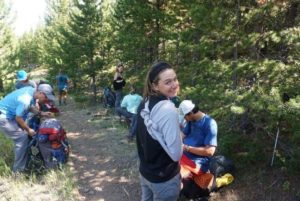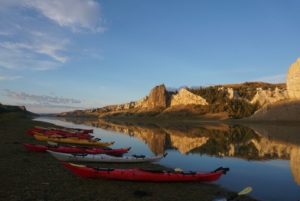 Sitting in the Great Falls doctor’s office with a sling on my right arm, I sighed, replaying the moment I dislocated my shoulder in the Bob Marshall Wilderness over and over in my head like a broken record. I almost couldn’t comprehend that days before we had been blissfully trekking along and now I was masked up in a dimly lit waiting room, truly not knowing what would come next. The fear of missing out on the upcoming 100+ mile paddle on the Missouri River with my group was looming like a dark cloud over me, and there was nothing I wanted more in that moment than to flee to our next backcountry destination where the breathtaking landscape before us would dissolve my worries.
Sitting in the Great Falls doctor’s office with a sling on my right arm, I sighed, replaying the moment I dislocated my shoulder in the Bob Marshall Wilderness over and over in my head like a broken record. I almost couldn’t comprehend that days before we had been blissfully trekking along and now I was masked up in a dimly lit waiting room, truly not knowing what would come next. The fear of missing out on the upcoming 100+ mile paddle on the Missouri River with my group was looming like a dark cloud over me, and there was nothing I wanted more in that moment than to flee to our next backcountry destination where the breathtaking landscape before us would dissolve my worries.
It is an understatement to say I felt fortunate to get the okay from the doctor to go out on the river (with the help of an innovative towing system and our course intern Zack, my personal water taxi driver). Floating in my kayak, I was given the time to do exactly what I needed: heal. I looked around in awe at the towering sandstone formations and sparkling water and exhaled a sigh of relief, feeling the muscles in my body finally relax as the waves and kayak rocked me back and forth.
As our time on the river progressed, I began to learn that the land on the Missouri River Floodplain has experienced significant changes and in so many ways, it too has endured injuries and damage. These scars are visible today, from the cows on the banks, cottonwood trees desperately trying to survive, and vestiges of abandoned homesteads scattered across the arid landscape. As I float along, I think about how my personal recovery will only be possible with the help of the people around me and more importantly, time. The land along the Missouri River is trying to heal and, like me, needs time and support.
The Missouri Breaks was designated as a National Monument in 2001 for the conservation of cottonwood trees, which were declining due to a lack of natural flooding after the establishment of upstream dams. Paradoxically, cows were left to graze on the land due to pressure from ranchers and landowners, and the cows eat cottonwoods saplings in the early stages of their growth, not giving them a great chance to survive into the towering, beautiful trees that provide shade and character to the Missouri Breaks.
Cows are everywhere in the Missouri Breaks National Monument. Look around and if you don’t see an actual cow, simply look down and notice the cow patties scattered as far as the eye can see. Cows have contributed to poor water quality, destroyed riparian zones, and overgrazed grasslands. Although the landscape has evolved with large grazers such as bison, the number and behavior of cattle on federally leased land is ecologically unsustainable. Ranchers and conservationists sit on opposite sides of the spectrum regarding their land use desires, leaving a landscape before our eyes that is so entrenched in history and debate that a middle ground seems out of reach.
Over time there have been constant political disagreements over how to best use the land, often leading to ecological suffering. Contemplating this history today, I wonder what the land needs right now to heal. When I first hurt my shoulder, I needed help from my friends doing basic things like pitching my tent and packing my bag. It truly does take a village. Now I mainly need time and strength. I wonder if the land also needs support from others to heal. Maybe we should be removing cows and frantically planting cottonwoods with cages around them to stop the grazing. But maybe it just needs time—a hands-off approach where Mother Nature is left to work her magic. There is clearly no easy solution, because if there were it would’ve already been implemented by now, but I believe collaboration will help the land in the ever-evolving process of healing.
I think collaboration means that we must first heal relationships among stakeholders before healing of the land can accelerate. Conservationists want ecological health and wildlife protection while ranchers need to preserve their culture and protect their livelihoods. In a short month, we have already seen encouraging evidence of collaborative solutions from our guest speakers, such as regenerative agricultural practices from a rancher south of Malta and the development of collaborative groups that facilitate difficult conversations between stakeholders. Middle ground might seem hard to reach, but if stakeholders don’t engage with one another and understand different perspectives on land use, a stalemate that is far too familiar in environmental issues will continue on.
The Missouri River Floodplain will likely never be the landscape it once was: an intact grassland where bison ranged freely on the grasses that had coevolved with them. Homesteads came and went on the land, trees grew and died, and cows continued to graze, all contributing to the state of the Missouri River Floodplain at precisely this moment in time. People and land are constantly changing and evolving, and to try to restore something—or someone—to a precise state they used to be in feels unnatural. It seems there are no easy solutions to please all stakeholders of the Missouri River Breaks National Monument, but it must start with building and healing relationships between people and the land. I know firsthand that the land has the power to heal and have no doubt that people can do the same for the land. 
Ani McMannon is a student at the University of Vermont where she studies Environmental Studies and minors in Spanish.
One Reply to “Healing in the Missouri River Breaks By Ani McMannon”
Comments are closed.
I appreciate you sharing your personal story and juxtaposing it with that of the land. Yours is a very thoughtful insightful piece. It’s reassuring knowing that you are all out there experiencing and learning about the land and our relationships with it. I too believe that collaboration is the key to achieving a healthy balance in our relationships with nature. It’s exciting, inspiring and hopeful to know that a new generation is making that a priority in your lives and work.